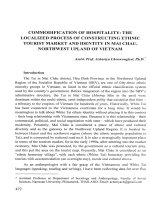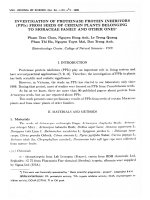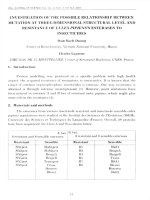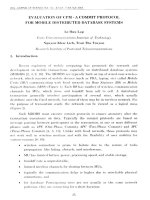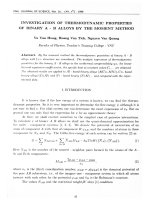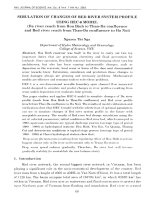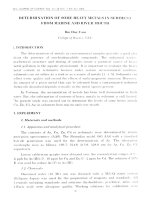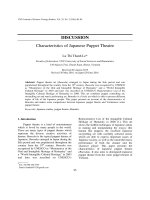DSpace at VNU: Downregulation of CD44 reduces doxorubicin resistance of CD44(+)CD24(-) breast cancer cells
Bạn đang xem bản rút gọn của tài liệu. Xem và tải ngay bản đầy đủ của tài liệu tại đây (286.81 KB, 8 trang )
About
Contact
Sustainability
Press Releases
Testimonials
Blog
Favored Author Program
Permissions
Pre-Submission
Login
open access to scientific and medical research
Advanced search
Home
Browse Journals
Why Dove?
Editors-in-Chief
Author Guidelines
Peer Review Guidelines
Open Outlook
Average Article Statistics
24 Days
*
from submission to first editorial decision.
22 Days
*
from editorial acceptance to publication.
*Business days (Mon-Fri)
30971
Papers Published
Submit Manuscript
Journal Email Alerts
Signup for Alerts
About Dove Press
Open access peer-reviewed scientific and medical journals.
Learn more
Open Access
Dove Medical Press is a member of the OAI.
Learn more
Reprints
Bulk reprints for the pharmaceutical industry.
Learn more
Favored Authors
We offer real benefits to our authors, including fast-track processing of papers.
Learn more
Social Media
Back to Browse Journals » OncoTargets and Therapy » Volume 4
Original Research
Highly Accessed
Downregulation of CD44 reduces
doxorubicin resistance of CD44+CD24- breast
cancer cells
Abstract
Fulltext
Metrics
Get Permission
Authors Phuc PV, Nhan PLC, Nhung TH, Tam NT, Hoang NM, Tue VG, Thuy DT, Ngoc PK
Published 21 June 2011 Volume 2011:4 Pages 71—78
DOI />Review by Single-blind
Peer reviewer comments 3
Pham Van Phuc, Phan Lu Chinh Nhan, Truong Hai Nhung, Nguyen Thanh Tam, Nguyen Minh
Hoang, Vuong Gia Tue, Duong Thanh Thuy, Phan Kim Ngoc
Laboratory of Stem Cell Research and Application, University of Science, Vietnam National
University, Ho Chi Minh, Vietnam
Background: Cells within breast cancer stem cell populations have been confirmed to have a
CD44+CD24- phenotype. Strong expression of CD44 plays a critical role in numerous types of
human cancers. CD44 is involved in cell differentiation, adhesion, and metastasis of cancer cells.
Methods: In this study, we reduced CD44 expression in CD44+CD24- breast cancer stem cells
and investigated their sensitivity to an antitumor drug. The CD44+CD24- breast cancer stem cells
were isolated from breast tumors; CD44 expression was downregulated with siRNAs followed
by treatment with different concentrations of the antitumor drug.
Results: The proliferation of CD44 downregulated CD44+CD24- breast cancer stem cells was
decreased after drug treatment. We noticed treated cells were more sensitive to doxorubicin,
even at low doses, compared with the control groups.
Conclusions: It would appear that expression of CD44 is integral among the CD44+CD24- cell
population. Reducing the expression level of CD44, combined with doxorubicin treatment, yields
promising results for eradicating breast cancer stem cells in vitro. This study opens a new
direction in treating breast cancer through gene therapy in conjunction with chemotherapy.
Keywords: antitumor drugs, breast cancer stem cells, CD44, CD44+CD24- cells, doxorubicin
This work is published and licensed by Dove Medical Press Limited. The full terms of this
license are available at and incorporate
the Creative Commons Attribution - Non Commercial (unported, v3.0) License. By accessing the
work you hereby accept the Terms. Non-commercial uses of the work are permitted without any
further permission from Dove Medical Press Limited, provided the work is properly attributed.
For permission for commercial use of this work, please see paragraphs 4.2 and 5 of our Terms.
Download Article [PDF] View Full Text [HTML][Machine readable]
Other articles by this author:
Original Research
Targeting breast cancer stem cells by dendritic cell vaccination in humanized
mice with breast tumor: preliminary results
Pham PV, Le HT, Vu BT, Pham VQ, Le PM, Phan NLC, Trinh NV, Nguyen HTL, Nguyen ST,
Nguyen TL, Phan NK
OncoTargets and Therapy 2016, 9:4441-4451
Published Date: 21 July 2016
Original Research
Low concentrations of 5-aza-2'-deoxycytidine induce breast cancer stem cell
differentiation by triggering tumor suppressor gene expression
Phan NLC, Trinh NV, Pham PV
OncoTargets and Therapy 2016, 9:49-59
Published Date: 23 December 2015
Original Research
Highly Accessed
Targeting specificity of dendritic cells on breast cancer stem cells: in vitro and in
vivo evaluations
Nguyen ST, Nguyen HL, Pham VQ, Nguyen GT, Tran CD, Phan NK, Pham PV
OncoTargets and Therapy 2015, 8:323-334
Published Date: 30 January 2015
Methodology
Highly Accessed
A simple in vitro method for evaluating dendritic cell-based vaccinations
Pham PV, Nguyen NT, Nguyen HM, Khuat LT, Le PM, Pham VQ, Nguyen ST, Phan NK
OncoTargets and Therapy 2014, 7:1455-1464
Published Date: 18 August 2014
Original Research
Highly Accessed
Suppression of human breast tumors in NOD/SCID mice by CD44 shRNA gene
therapy combined with doxorubicin treatment
Pham PV, Vu NB, Duong TT, Nguyen TT, Truong NH, Phan NLC, Vuong TG, Pham VQ,
Nguyen HM, Nguyen KT, Nguyen NT, Nguyen KG, Khat LT, Le DV, Truong KD, Phan NK
OncoTargets and Therapy 2012, 5:77-84
Published Date: 7 May 2012
Readers of this article also read:
Review
Highly Accessed
Causative factors for formation of toxic islet amyloid polypeptide oligomer in
type 2 diabetes mellitus
Jeong HR, An SSA
Clinical Interventions in Aging 2015, 10:1873-1879
Published Date: 19 November 2015
Review
Highly Accessed
Emerging and future therapies for hemophilia
Carr ME, Tortella BJ
Journal of Blood Medicine 2015, 6:245-255
Published Date: 3 September 2015
Review
Highly Accessed
Mutations in presenilin 2 and its implications in Alzheimer’s disease and other
dementia-associated disorders
Cai Y, An SSA, Kim SY
Clinical Interventions in Aging 2015, 10:1163-1172
Published Date: 14 July 2015
Original Research
Highly Accessed
Green synthesis of water-soluble nontoxic polymeric nanocomposites containing
silver nanoparticles
Prozorova GF, Pozdnyakov AS, Kuznetsova NP, Korzhova SA, Emel’yanov AI, Ermakova TG,
Fadeeva TV, Sosedova LM
International Journal of Nanomedicine 2014, 9:1883-1889
Published Date: 16 April 2014
Original Research
Highly Accessed
Methacrylic-based nanogels for the pH-sensitive delivery of 5-Fluorouracil in the
colon
Ashwanikumar N, Kumar NA, Nair SA, Kumar GS
International Journal of Nanomedicine 2012, 7:5769-5779
Published Date: 15 November 2012
Original Research
Highly Accessed
Cross-linked acrylic hydrogel for the controlled delivery of hydrophobic drugs in
cancer therapy
Deepa G, Thulasidasan AK, Anto RJ, Pillai JJ, Kumar GS
International Journal of Nanomedicine 2012, 7:4077-4088
Published Date: 27 July 2012
Original Research
Highly Accessed
Particle size reduction to the nanometer range: a promising approach to improve
buccal absorption of poorly water-soluble drugs
Rao S, Song Y, Peddie F, Evans AM
International Journal of Nanomedicine 2011, 6:1245-1251
Published Date: 20 June 2011
Review
Highly Accessed
Current and developing therapeutic agents in the treatment of Chagas disease
Werner Apt
Drug Design, Development and Therapy 2010, 4:243-253
Published Date: 17 September 2010
Case report
Highly Accessed
Crystallization after intravitreal ganciclovir injection
Pitipol Choopong, Nattaporn Tesavibul, Nattawut Rodanant
Clinical Ophthalmology 2010, 4:709-711
Published Date: 14 July 2010
Original Research
Highly Accessed
Characterization of complexation of poly (N-isopropylacrylamide-co-2(dimethylamino) ethyl methacrylate) thermoresponsive cationic nanogels with
salmon sperm DNA
Jim Moselhy, Tasnim Vira, Fei-Fei Liu, et al
International Journal of Nanomedicine 2009, 4:153-164
Published Date: 24 August 2009
Contact Us • Privacy Policy • Associations & Partners • Testimonials • Sitemap • Terms
& Conditions • Recommend this site • Top
© Copyright 2017 • Dove Press Ltd • Website development by maffey.com • Web Design
by Adhesion
The opinions expressed in all articles published here are those of the specific author(s), and do
not necessarily reflect the views of Dove Medical Press Ltd or any of its employees.
страничка проекта Sci-Hub в социальных сетях →
Sci-Hub
https://w w
URL статьи или журнала, или DOI, или строка для поиска
▶
Помочь проекту

